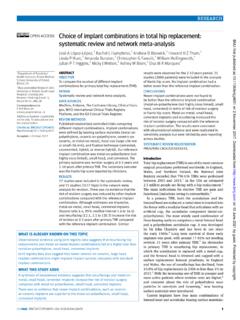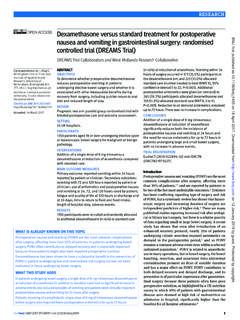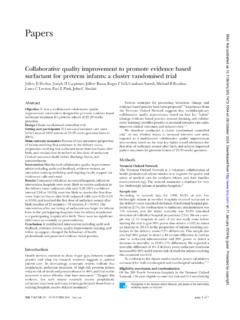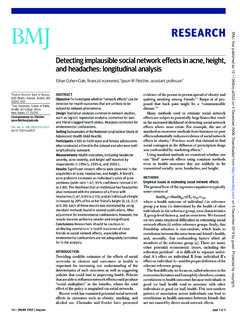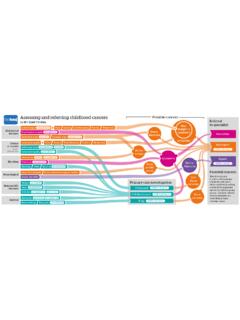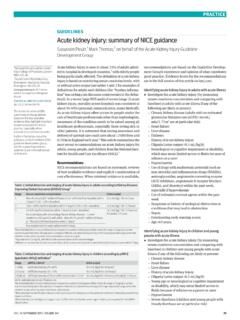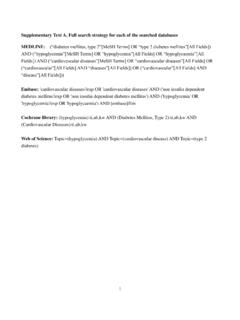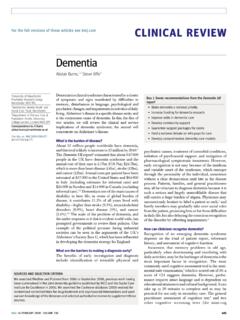Transcription of PRISMA 2020 explanation and elaboration: updated guidance ...
1 RESEARCH METHODS AND REPORTINGthe bmj | BMJ 2021;372:n160 | doi: 1 PRISMA 2020 explanation and elaboration: updated guidance and exemplars for reporting systematic reviewsMatthew J Page,1 David Moher,2 Patrick M Bossuyt,3 Isabelle Boutron,4 Tammy C Hoffmann,5 Cynthia D Mulrow,6 Larissa Shamseer,7 Jennifer M Tetzlaff,8 Elie A Akl,9 Sue E Brennan,1 Roger Chou,10 Julie Glanville,11 Jeremy M Grimshaw,12 Asbj rn Hr bjartsson,13 Manoj M Lalu,14 Tianjing Li,15 Elizabeth W Loder,16 Evan Mayo-Wilson,17 Steve McDonald,1 luke A McGuinness,18 Lesley A Stewart,19 James Thomas,20 Andrea C Tricco,21 Vivian A Welch,22 Penny Whiting.
2 18 Joanne E McKenzie1 The methods and results of systematic reviews should be reported in sufficient detail to allow users to assess the trustworthiness and applicability of the review findings. The Preferred Reporting Items for Systematic reviews and Meta-Analyses ( PRISMA ) statement was developed to facilitate transparent and complete reporting of systematic reviews and has been updated (to PRISMA 2020) to reflect recent advances in systematic review methodology and terminology. Here, we present the explanation and elaboration paper for PRISMA 2020, where we explain why reporting of each item is recommended, present bullet points that detail the reporting recommendations, and present examples from published reviews.
3 We hope that changes to the content and structure of PRISMA 2020 will facilitate uptake of the guideline and lead to more transparent, complete, and accurate reporting of systematic reviews are essential for healthcare providers, policy makers, and other decision makers, who would otherwise be confronted by an overwhelming volume of research on which to base their decisions. To allow decision makers to assess the trustworthiness and applicability of review findings, reports of systematic reviews should be transparent and complete.
4 Furthermore, such reporting should allow others to replicate or update reviews. The Preferred Reporting Items for Systematic reviews and Meta-Analyses ( PRISMA ) statement published in 2009 (hereafter referred to as PRISMA 2009)1-12 was designed to help authors prepare transparent accounts of their reviews, and its recommendations have been widely endorsed and We have updated the PRISMA 2009 statement (to PRISMA 2020) to ensure currency and relevance and to reflect advances in systematic review methodology and of this guidelineThe PRISMA 2020 statement has been designed primarily for systematic reviews of studies that evaluate the effects of health interventions, irrespective of the design of the included studies.
5 However, the checklist items are applicable to reports of systematic reviews evaluating other non-health-related interventions (for example, social or educational interventions), and many items are applicable to systematic reviews with objectives other than evaluating interventions (such as evaluating aetiology, prevalence, or prognosis). PRISMA 2020 is intended for use in systematic reviews that include synthesis (such as pairwise meta-analysis or other statistical synthesis methods) or do not include synthesis (for example, because only one eligible study is identified).
6 The PRISMA 2020 items are relevant for mixed-methods systematic reviews (which include quantitative and qualitative studies), but reporting guidelines addressing the presentation and synthesis of qualitative data should also be 15 PRISMA 2020 can be used for original systematic reviews, updated systematic reviews, or continually updated ( living ) systematic reviews. However, for updated and living systematic reviews, there may be some additional considerations that need to be addressed. Extensions to the PRISMA 2009 statement have been developed to guide reporting of network meta-analyses,16 meta-analyses of individual participant data,17 systematic reviews of harms,18 systematic reviews of diagnostic test accuracy studies,19 and scoping reviews20; for these types of reviews we recommend authors report their review For numbered affiliations see end of the to: M Page 0000-0002-4242-7526)Additional material is published online only.
7 To view please visit the journal this as: BMJ 2021;372:n160 : 4 January 2021 SUMMARY POINTSThe PRISMA 2020 statement includes a checklist of 27 items to guide reporting of systematic reviewsIn this article we explain why reporting of each item is recommended, present bullet points that detail the reporting recommendations, and present examples from published reviewsWe hope that uptake of the PRISMA 2020 statement will lead to more transparent, complete, and accurate reporting of systematic reviews, thus facilitating evidence based decision making on 12 September 2022 by guest. Protected by : first published as on 29 March 2021.
8 Downloaded from RESEARCH METHODS AND REPORTING2 doi: | BMJ 2021;372:n160 | the bmjin accordance with the recommendations in PRISMA 2020 along with the guidance specific to the extension. Separate guidance for items that should be described in protocols of systematic reviews is available ( PRISMA -P 2015 statement).21 22 PRISMA 2020 explanation and elaborationPRISMA 2020 is published as a suite of three papers: a statement paper (consisting of the 27-item checklist, an expanded checklist that details reporting recommendations for each item, the PRISMA 2020 abstract checklist, and the revised flow diagram23); a development paper (which outlines the steps taken to update the PRISMA 2009 statement and provides rationale for modifications to the original items24).
9 And this paper, the updated explanation and elaboration for PRISMA 2020. In this paper, for each item, we explain why reporting of the item is recommended and present bullet points that detail the reporting recommendations. This structure is new to PRISMA 2020 and has been adopted to facilitate implementation of the 26 Authors familiar with PRISMA 2020 may opt to use the standalone statement paper23; however, for those who are new to or unfamiliar with PRISMA 2020, we encourage use of this explanation and elaboration document.
10 Box 1 includes a glossary of terms used throughout the PRISMA 2020 explanation and elaboration use standardised language in the explanation and elaboration to indicate whether the reporting recommendations for each item (which we refer to as elements throughout) are essential or additional. Essential elements should be reported in the main report or as supplementary material for all systematic reviews (except for those preceded by , which should only be reported where applicable). These have been selected as essential because we consider their reporting important for users to assess the trustworthiness and applicability of a review s findings, or their reporting would aid in reproducing the findings.


